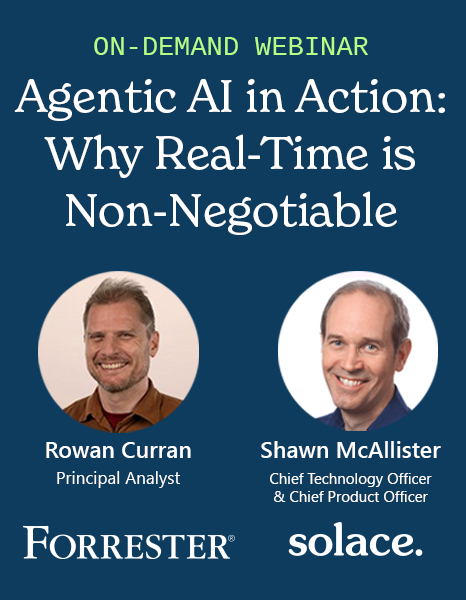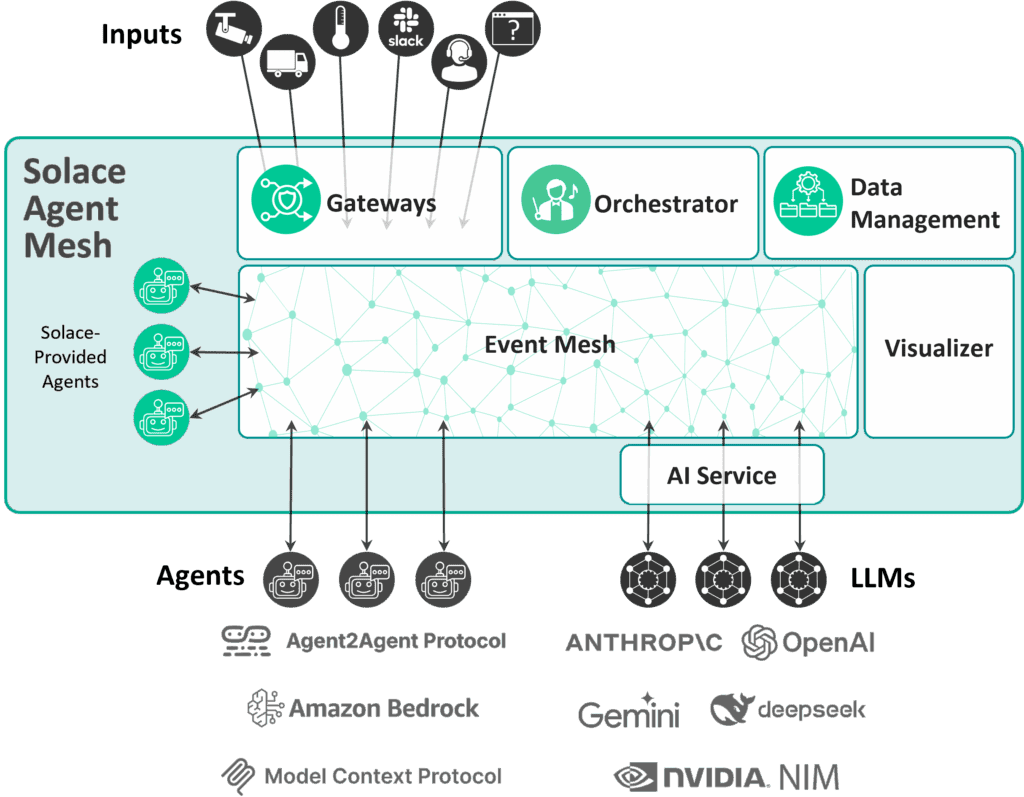Home > Blog > Artificial Intelligence
Subscribe to Our Blog
Get the latest trends, solutions, and insights into the event-driven future every week.
Thanks for subscribing.
Note: My colleague Ali recently introduced Solace Agent Mesh with this blog post that offers an excellent overview of it’s raison d’atre, capabilities and components. With this blog post, and the series of videos I’ve created, my goal is to flesh out your understanding a little bit so you can feel more confident getting started.
Picture this. It’s 2024 and you are in a lab with Tony Stark, aka Iron Man, working on the next evolution of AI. You mix together generative AI, large language models, software patterns, and architectural principles and end up creating autonomous AI agents that have the potential to revolutionize the future of enterprise-wide adoption of AI in the industry. You’re ecstatic about this, but quickly realize that you need some sort of infrastructure to allow for agent-to-agent communication and orchestration in a non-siloed approach for the true potential to shine.
Welcome to 2025 — the year agentic AI steps out of the lab and onto the stage of real-world enterprise adoption. Companies are rapidly adopting agentic AI to boost operational efficiency, drive innovation, improve customer experiences, and enhance decision-making
The Real Challenge of Agentic AI: Integration
But as you start dabbling in AI projects and delve deeper, a startling reality continues to surface: for most projects, only about 20% of the challenge is the AI technology itself; the other 80% are fundamental integration and data challenges. Connecting those intelligent agents to the necessary data and systems, but also getting real-time data updates is where things get tricky.
Why is that, you may ask? Well, traditional integration methods like polling or batch processing introduce latency and data staleness, limiting AI’s ability to react in real-time and potentially leading to inaccurate results or AI hallucinations. AI assets, like agents introduced in isolation, create new data silos and rigid architectures, hindering the building of new applications. Bringing AI trials to enterprise scale requires a robust foundation—not to mention careful planning, governance, security, and scalability to say the least.
The Solution: Solace Agent Mesh
This is precisely the problem Solace Agent Mesh is designed to solve. Solace Agent Mesh is an open-source agentic AI framework built on top of Solace Platform for enterprise-ready event-driven Agentic AI. It’s designed to empower developers, architects, and AI enthusiasts to build scalable, multi-agent systems while seamlessly interacting with real-time data. It also provides a flexible foundation for building AI applications where multiple agents can collaborate effectively.
Rather than being a monolithic AI platform, Solace Agent Mesh excels as an integration layer, connecting specialized agents with data sources and systems to solve complex problems. It’s engineered for production deployment, leveraging Solace’s 20+ years heritage in building mission-critical distributed systems.
Approach and Components
Built on A2A principles using Google’s ADK, Solace Agent Mesh adopts an event-driven approach that embraces the fluidity and complexity of business events, unlike traditional AI pipelines that rely on batch processing and REST APIs. This is achieved through the following main components: an orchestrator, gateways, agents, services, and an event mesh.
Let’s do a quick deep dive into each component.
Orchestrator: The Conductor of Cognitive Workflows
The Orchestrator decomposes complex tasks into actions, dynamically routing them to the target agents. It uses real-time agent capability discovery and LLM-driven intent matching to adapt to changing conditions. After creating and distributing tasks to agents, the responses are aggregated in format that matches the final output for the original requestor.
Gateways: Secure Entry and Routing Layer
Gateways are entry and exit points to the system, providing the user interface and controlling the system persona. Each gateway can have a configurable purpose and output formatting tailored to specific use cases or interfaces. Agent mesh offers different types of built-in gateways and supports custom built interfaces for use-case specific requirements. Gateways also enable identity-aware routing restricting access to agents, actions, and data based on the authenticated user. For example, a customer service gateway might restrict agents to order history access, while an internal ops gateway grants full inventory visibility.
Agents: Autonomous AI Workers
These are specialized processing units with access to LLMs, embeddings, and other services in the agent mesh. Agents have a list of actions representing specific capabilities providing domain knowledge beyond a basic LLM response. Agents self-register their capabilities via the event mesh, enabling true plug-and-play scalability and modularity.
Services: The Business Logic Backbone
Think of services as the system-wide capabilities used by various components and available as independent stateless functionalities. Such services include file service for efficient handling of files without overwhelming models and the agent mesh, history service for flexible session memory storage and internal state handling, LLM service for configuring and managing models, and the embedding service to manage access to text, image, or multi-modal embedding models.
Event Mesh: The Real-Time Communication Backbone
The event mesh – powered by Solace Event Broker, handles the real-time communication piece between all the Agent Mesh components along with events from the external world. It’s the “central nervous system” that facilitates event-based communication via pub/sub principles over Solace Topics. The event mesh leverages the underlying power of the Solace Broker including but not limited to low-latency, loosely coupled communication, cloud agnostic operations across different providers, on-prem, and edge environments, and system resiliency. This is the critical piece that provides real-time data movement between applications, data sources, and agents.
Final Thoughts
AI agents are only as powerful as the data they can access in real time — and that’s where Solace Agent Mesh shines. By leveraging an event-driven foundation, Solace Agent Mesh ensures that every system update, from inventory changes to customer actions, is instantly available to the agents that need it.
One critical aspect of modern AI is Retrieval Augmented Generation (RAG). RAG applications often rely on vector databases to provide external knowledge to LLMs. But the value of RAG diminishes if the data in the vector database is stale. Providing up-date context is essential for accurate, relevant AI outputs. The messaging architecture that’s built on top of the Solace Event Broker also enables efficient and secure agent to agent communication handling high volumes of data reliably across environments.
You can probably see where this is going, so buckle up—because we’re just getting started.
What’s Next?
If this blog sparked your curiosity, there’s so much more waiting for you!
- 👉 Check out the open-source GitHub repo and ⭐️star it
- 👉 Dive into the documentation to explore core concepts, APIs, and architecture patterns
- 👉 Join the discussion on the Solace Community AI forum — ask questions, share ideas, or showcase what you’re building
Why Real-Time Is Non-NegotiableOn-demand webinar featuring agentic AI case studies and expert analysis from Forrester.Watch the Webinar

Explore other posts from category: Artificial Intelligence

Tamimi enjoys educating people about and exploring innovative ways of integrating Solace technologies with emerging tools, technologies and techniques. With this focus in mind he’s helped Solace’s developer relations team run scores of virtual events for individual developers and partners alike, frequently presenting or facilitating tutorials and hands-on workshops.
Prior to Solace, Tamimi played a role at Qlik, a leading provider of business intelligence and data analytics solutions, and was an automation specialist for You.i TV which provides a platform for video streaming apps. His experience in those fields, combined with his event-driven architecture expertise, makes Tamimi highly sought after as a guest speaker on podcasts and – before COVID and hopefully soon again – in-person speaking engagements.
Tamimi enjoys all things tech, and has been actively supporting social entrepreneurship in the Ottawa-area tech community for over a decade. He currently serves as director of a non-profit called Connected Canadians that aims to reduce isolation amongst older adults by promoting digital literacy skills and providing technology training and support.
Tamimi holds a bachelor’s degree in communication engineering from Carleton University, and when he’s not immersed in technology he enjoys photography and DJing.


Subscribe to Our Blog
Get the latest trends, solutions, and insights into the event-driven future every week.
Thanks for subscribing.

